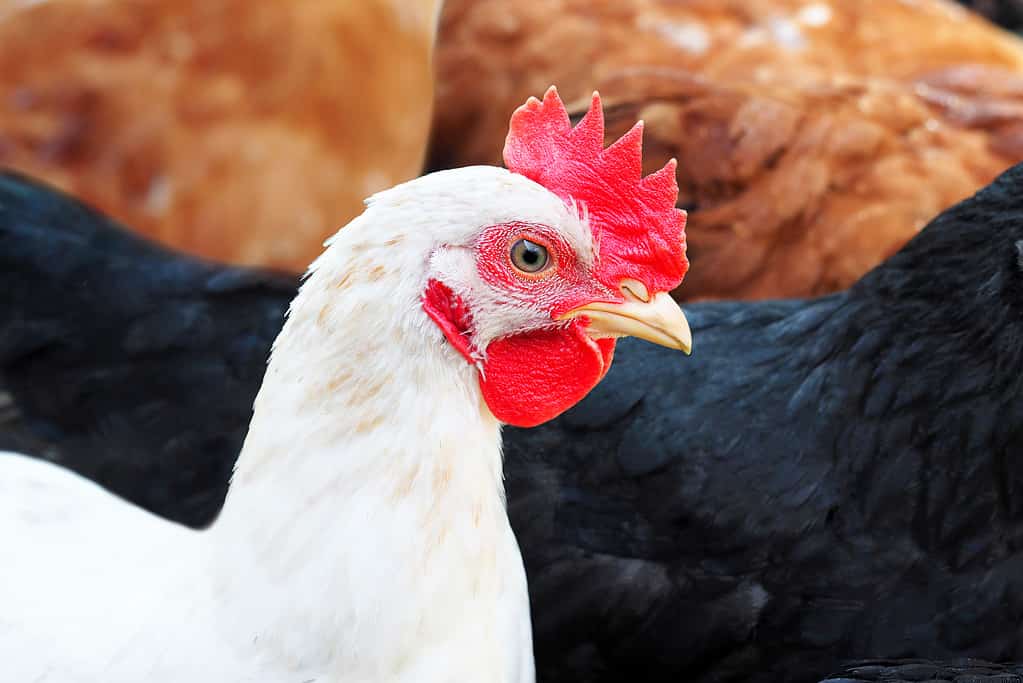Have you considered adding Leghorn chickens to your farm or backyard flock? These egg-laying experts are intelligent, spirited foragers who love to make noise and explore their surroundings. They are voracious egg layers that bring style and energy and have remained among the top favorite chicken breeds in the U.S. However, investing in a flock of chickens or building a bigger flock does take time and money. There are quite a few costs to take into consideration before purchasing leghorn chickens and making the ongoing commitment to their care. This article summarizes some of the costs you should anticipate before bringing home your first Leghorns.
About Leghorn Chickens

While industrial leghorn chickens are white, non-industrial leghorn chickens can be brown and other colors.
©Wirestock Creators/Shutterstock.com
Leghorn chickens are an egg-laying breed of chicken that originated from Italy but which crossed the Atlantic Ocean in the early 1900s in a hybridized version. Today, Leghorns come in a range of colors and tend to have a game-bird-like appearance. The typical Leghorn rooster weighs about 6 pounds while hens weigh 4-5 pounds. Since Leghorns are a very prolific egg-laying breed, many people choose to bring these chickens home in the hope of getting between 150 and 300 large or extra-large eggs every year. However, the downside of having such productive egg-laying years is that the average Leghorn hen only lives between 4 and 6 years.
Leghorns are best for those experienced with keeping chickens and who want good egg-layers. They are not a good breed for those looking to have a “pet” chicken or people who live in an urban or suburban setting where noisy animals will be a nuisance.
Purchasing Leghorn Chickens

Leghorn chickens are a Mediterranean variety that originated in the Tuscany region of Italy.
©slowmotiongli/Shutterstock.com
Those who want to purchase Leghorn chickens have several options for buying these creatures. Since chickens are social animals and meant to live in a flock, many hatcheries and reputable stores will sell Leghorn chicks in groups. With that in mind, expect to purchase a minimum number of chickens – many places sell them in groups of 5 or 10. Depending on where you purchase the chicks, you can typically purchase Leghorns for $25 to $30 to get a group of 5 to 10 chicks. However, you may find that buying Leghorn chickens in larger groups, such as 50, 100, or more, to reduce the cost per chick.
Leghorn Chicken Supplies

Leghorn chickens do not need a lot of special supplies.
©ANGHI/iStock via Getty Images
Before you bring your Leghorn chickens home, it is important to prepare with the necessary supplies for their care and feeding. Leghorn chickens do not need any special supplies. If you have raised chicks before, you may be able to reuse the same equipment again.
As you raise the chicks, provide them with consistent access to food and fresh water at all times. Chicks may need a heat lamp or other source of warmth to keep them warm, and consider providing the heat throughout the winter to prevent water from freezing in the cold.
Once your chicks get bigger and are ready to live full-time in an outdoor coop, continue giving them access to food and water at all times to keep the birds safe and healthy. You can build nesting boxes, line them with straw or wood, and place the boxes in a quiet and safe area where your Leghorn hens can lay eggs. Check for new eggs each day and remove them regularly to make space for the new eggs.
Chicken Feed

Baby chicks eat a special formula of feed made for their age.
©iStock.com/Jennifer Chamblee
Leghorn chicks will need special chick feed made for their early stage of growth and development, with specific formulations that bring protein and other nutrients together in the right quantities. You can expect to pay between $25 and $30 for a large (50-pound) bag of chick feed, though there is a wide range of brands and options available that could cost much more. As your chicks age, you will want to graduate them from chick feed to adult chicken feed. A 50-pound bag of feed can last about 7 to 8 weeks for a flock of four hens, so you will need to purchase feed more often if you are tending a larger flock. Leghorn chickens can eat standard chicken food.
In addition to feed, some choose to give their chickens extra supplements or vitamins. These additions could cost between $4.00 and $10.00 to give to the entire flock, with options including everything from feed supplements to electrolyte formulas to add to their water.
Setting Up a Coop

You can build a chicken coop at home or purchase a kit that gives specific instructions for how to set it up.
©Cynthia Farmer/Shutterstock.com
Constructing a chicken coop is a vital step in raising your flock. You will need enough space in your outdoor yard or garden so that your flock can move and forage, as well as a space where they can shelter at night and lay eggs. Leghorn chickens in particular are known for being active, energetic, and talented foragers, so giving them outdoor space to stretch their legs and explore is important. When it comes to building a good chicken coop, you will want to include places where your hens can roost, such as a perch or shelf. This will help your hens stay happy and healthy and give them protection from predators. Make sure you place your nesting boxes in quiet, safe places where your hens will feel comfortable laying eggs but you are able to collect them on a daily basis.
If you are not a confident craftsman and want to start a coop from a kit, you can expect to spend several hundred dollars. You can find kits to build smaller coops for between $200 and 500. More elaborate coops could cost over $1,000. However, if you feel confident in your ability to “do it yourself,” there are plenty of DIY chicken coop plans and tips accessible online.
The size you need for your coop will depend on the size of your flock. Make sure that you have enough nesting boxes and that the design for your chicken coop is sturdy enough to keep your Leghorns safe and protected from potential predators, such as snakes or foxes.
The photo featured at the top of this post is © Jay-Dee/Shutterstock.com
Thank you for reading! Have some feedback for us? Contact the AZ Animals editorial team.






